Written journalism, from pencil to sharp!

Those of us who are around the age of 40 when we chose this badly paid job, things, although at the base were similar, were more difficult. Journalism has not been left out of the enormous scientific and technological development of the last 25 years.
In the written press, although sometimes written by hand – both with pencil and pen, and the most ambitious with pen – the main working tool was the typewriter. Compared to today's computers, it was a clumsy tool, but it did well to write, always depending on the writer's skill. The most common problems were the chaining, termination or deterioration of the ink conveyor belt, usually when there was a lot of haste. In general, journalists wrote more attentively than today, as machine errors were not solved as easily as computer errors. However, dirty papers often came to those who were going to make the model.

Although alongside handwriting methods the machine was a breakthrough, the arrival of the Tipp-Ex to the world of noisy keys cannot say it was a revolution, but it is important. Black and blue spots disappeared in one of the papers and appeared white. There were the spots, but hidden. Therefore, the work of the Maquetists of the written media was greatly facilitated.
Goodbye to the typometer
The way the model is made has also changed a lot. The maquetist collects texts worked on current computers in processing texts without touching paper. On the computer screen he has a pre-model –flat– of the newspaper or magazine. Place the received texts, the size of the letters, the type of letter, the color, the treatment and selection of the photographs, the titles, the lines, the corrections, the graphics… all in a computer. Without moving from your site, send the model to the machines so that they can make copies.
20 years ago the process of making models in written media was more laborious. Journalists or maquetists, according to the organization, had empty pages of the newspaper or magazine. Sometimes we worked on what and how much they were going to have planned, and depending on it the text and the graphic material were worked, while in others a space was made in the newspaper or in the magazine depending on the materials and their importance. In both cases, models were made that reflected the text and graphic elements.

Currently to decide the size of the letters or change the font just press a couple of keys on the computer. Then the typometer was used to know how many lines, what size and what type of letter would enter the model, and how many lines in the simple text of so many characters.
The typometer is a special rule for the media. It is used to measure the size of letters. The typometer shows the number of characters, letters or types that are inserted in each of the lines of the newspaper or magazine of a certain size. And, therefore, making a rule of three simple, the writer knows how many lines in a row he should write. It is also used to measure titles, photographs and advertising modules. Although the rule of three is simple, the system causes quite headaches, since mathematics and prose – mathematicians and journalists – have historically not married very well.
Pencil
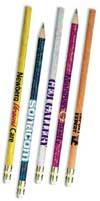
Pencil is one of the most interesting and effective discoveries in the history of writing. Inside it presents a mixture of graffiti and clays. The idea of joining this mixture into two parts of wood is from the American William Monroe, 1812. Along with other systems that use liquids, the pencil has the advantage that it is easily removable.
Ballpoint pen
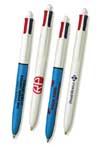
The first patent of the pen was held in Hungary in 1938 by Ladislao Biro and under the name of Birome. He was a Jewish vile who in 1940 had to flee from the Germans. He arrived in Argentina and there he re-registered his invention.
Biro placed at the end of a pen a ball that leaves an ink mark as they spin.
They say photographic art

Along with the texts, the pages of the written media were filled with photographs. At the base, there are no big differences between the work of current and former photographers. The photo is taken, revealed and printed with all other elements. But in terms of resources, in the fourth century there has been a great escalation.
25 years ago to make good photos, besides doing a lot, you had to know how to take them. Take care of the light, put the diaphragm more open or closed, calculate the distance, decide the exposure time… photography was a field of work reserved for artists. Then, in addition, the photos had to be revealed, in record time, how and how in these conditions. There was a close relationship between photographers and the dark room; revealed liquids, photographic paper, liquid to curb the development, fixative, … were raw material for the photographers' labor. Often in the newsrooms nervousness prevailed until the photographer opened the doors of the dark room.
At that time, the journalists we only knew how to write supposedly, today we also take good pictures. Experience will have to do with it, but the main reason has been the advancement of technology. In fact, current cameras, if they are not in danger of breaking, can be used by children. Just put the camera automatically, do the framing you want and press the button, the rest does it himself: focus the motif, measure the light, decide the exposure time….
Digital cameras that have appeared and are developing in recent years have also changed the way photographers work. Dark rooms are filled with cobwebs. Photos are taken, passed to the computer, if necessary the last touches are given with computer programs to treat the images, and once the selection is made on screen, they are sent directly to print the photos through the computer, without touching neither the negatives nor the papers.
Photo camera
In 1822 Joseph N. French inventor Niepce obtained the first permanent photograph. However, it did not overtake until 1839. That same year, the French Louis Jacques Mande Daguerre got the light to affect a suspension of silver salt as she had prescribed. The test went well, but to complete the process it took half an hour and it was very difficult to make copies. In 1841 the British William Henry Talbot overcame the problem, as he first made negative images and then invented a system to make positive in other roles.
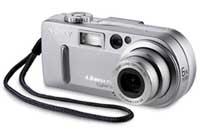
From there, work began to accelerate printing time. In 1871 R.L. Maddox obtained the first stable dry plates, which reduced the exposure time and allowed the invention of the shutter. As a result, the first small cameras came to market in 1888, the Kodak cameras. In 1907 the first color photos were taken and in 1947 the Polaroid cameras.
Nowadays, digital cameras invented by astronomical research are making room in the market, they can be fully automatic, you can see images immediately, load them on the computer, retouch them, etc.
Bicycle, fax, email
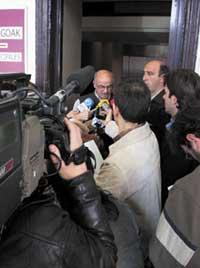
And as we mentioned the shipping accounts, some lines can be offered to advance the resources available to move the material from one place to another. Those of us who started working at the lowest level of journalism, chronicling their country, know perfectly the work that offered to see the chronicle published for the next day.
Many times we dictated chronicles on the phone – sometimes improvising them – but they usually arrived by bus or taxi to newspaper newsrooms. I, with better shape than now, from time to time also carried them by bicycle. Logically, calling on the phone was faster, but for those who had to receive the texts written by the journalist it was more convenient to pick them up on paper than by phone.
When the fax was invented it concluded that for the chroniclers of the villages it was at the height of the bus schedule, but do not think that it entered immediately. At first, being in bookstores, photocopiers and institutions, the chroniclers of the villages had to go to their schedule. At present, it is clear that the importance of fax is getting smaller, since the email has taken away great space, although what must be sent is the paper itself and the fax remains essential.
Fax machine
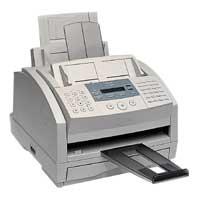
Fax is a new invention (1980) although the basic idea is XX. German Arthur Korn put it in the early 20th century. Korner invented the process called telefoto. During this process I could collect in images the signals sent by a cable. In 1980, RCA, Sharp and Xerox reviewed the idea and released the fax. He grouped the mail service and telephone communications into a single tool.
Telephone number
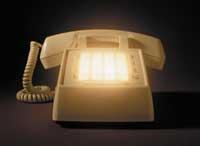
On February 14, 1876, Alexander Graham Bell applied for the first patent for an electromagnetic phone, although according to the latest news, the real inventor of the phone was the Italian Antonio Meucci. However, research had already begun long before. Robert Hook announced in 1667 that a string in tension can transmit sound. In 1820, the Danish Hans Christian Órsted discovered that electric currents affected magnetic needles.
He discovered electromagnetis. Taking advantage of this, twenty years later the Morse Telegraphs were underway. In 1878 the first worldwide telephone service was launched in the American city of New Haven. Since then, the telephone network has spread all over the world, replacing the poles loaded with initial cables with underground and submarine cables, to reach current wireless technologies thanks to the advancement of technology.
To record words
Another of the technological miracles that hit and expedited the work of journalists was the recorder. Until reaching us, journalists were tied to pencil or pen and paper. The notebook and pencil or pen were for journalists as an ear pencil for carpenters, part of our garment. Nowadays it cannot be said that they have disappeared or are about to disappear, but they are used less than a few years ago. And it is that one of the main signs of identity of journalists is – we will recognize it – anger. Therefore, in the press conferences, in the interviews… the recorders predominate.
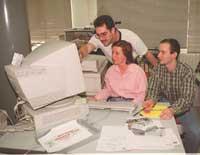
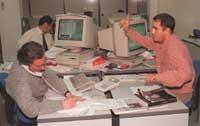
Writing instruments are also carried by hand, just in case, but when the speaker realizes that he speaks faster than one writes, they only serve to simulate or to fill the drawing papers. Of course, the recorders of a few years ago do not have much to do with the current ones. The news, however small it may be, records much better, allow to find concrete things in the recording quickly, double the recording time of the tapes...
Despite the large presence of recorders in presentations, press conferences, public meetings, etc., are a mistake next to mobile phones.
In those days when making a phone call, that is, the speed, was fundamental, the phones were not so available. There were telephone booths, but not in the place and at the time everyone wanted, and they were busy; they had to ask permission in the institutions to use the local phone, the phones that could be used without asking permission could reach their peers faster... in short, mobile phones improved the precarious working situation of journalists. Or maybe not.
This debate is not for these lines. The problem is that thanks to mobile phones communication between journalist, work and colleagues is much more complete than before. And it will continue to be more and more complete, because mobile phones, along with nonsense like notch switching, now have more effective options, such as email or internet access.
Recorder
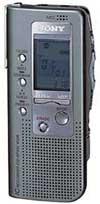
In 1935 the companies of Telefunken AEG and IG Farb manufactured a plastic band covered by a magnetic film. It was the origin of the recorder, the tape recorder. The invention began to be used in Germany, but after World War II, the Allies seized some German instruments, including the Magnetophones. The commercial production of recorders began.
To make a layout? Mac

And by citing both email and the internet, although it has been indirectly mentioned throughout the article, you can not ignore the computer. Although computers have many possibilities, they came to replace the typewriter in our profession. In this trade they began to be used as a mere word processor and, as has become clear when talking about the typewriter, his contribution was excellent. Later they were added the work of making models, making drawings or infographics and treating photos.
However, do not think that with the arrival of the computer the headaches of the models were finished, since conventional computers were not prepared for it. Macintosh computers were responsible for meeting the needs of graphic designers. From an aesthetic point of view, Macs were different because they had mouse and PCs were not. However, the computers at that beginning were very slow – little trained – for the needs of the written media, especially in cases where images had to be inserted. The actual change has occurred as the capacity and speed of the processors increases.
Typewriter
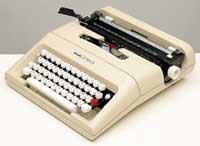
The first typewriter was made in the United States in 1829 by William Austin Bolsa. Characters or letters were placed on a wheel and then pressed onto the paper. It was slower than writing by hand. In 1833 the Frenchman Xabier Progin obtained the patent of a new typewriter, with the novelty that each character was placed in a billet. The contribution of the interline distance control roller was made by the American Charles Grover in 1843. In the following years several inventors tried to build embossed machines so that blind people could read. Thus, in 1856 a machine was invented that engraved letters in relief, but instead of engraving letters on a page they were engraved in strips of paper. That same year they patented the machine that had the letters on a circular stand and the keys as in the pianos. In 1873, at the Remington and Sons plant in New York, they continued working to manufacture typewriters.
It was the forerunner of modern typewriters: the paper was placed on a roller, with the pressure of the keys moved from right to left, a letter jump. Using a lever, the roller was brought back to the right and driven upwards. The letters were placed on a circular support. When the letters hit a tape full of inks, it drew the paper on the roller. Those first typewriters only wrote with masterpiece. In 1878, when devising the device that lowered the roller and the double key, they began to write in both the scam and the lower case. In the 1880s, in the United States, two new typewriter models appeared, the Blickensderfer wheel machine and the Hammond typewriter. In 1912 portable typewriters were taken out, from 1925 the electric ones began to be used... and in development they have reached the current typewriters: typewriters have become both photocopiers, computers, fax and printers.
Computer
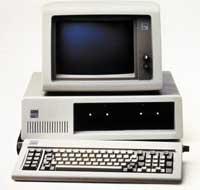
Analog computers XX. They appeared in the early years of the 20th century. These machines based on shafts and rotating blades were used for calculations. During World War II a team of English researchers developed the first electronic digital computer, the Colossus computer. He began work in December 1943. It had 1,500 valves and vacuum tubes. Later, larger computers were manufactured, such as the well-known ENIAC, with 18,000 valves. In the late 1950s, with the invention of the transmitter, the possibility of making smaller and more capable computers arose.
In the late 1960s the integrated circuit was invented, resulting in the possibility of placing several transsistors on the same plate. The microprocessor was a reality in the mid-1970s, until the integrated circuits appeared, which allow the placement of multiple freight forwarders on the same board. It was then that personal computers began to appear and that was when the real influence of computers began.
In progress
Everything mentioned and much more is done by computers today, but from the point of view of daily written journalism, the main revolution has been the Internet.
With the Internet, access to information sources has been equalled, online interviews can be carried out, video conferences can be organized, photos downloaded, embargoes break… all with the mouse. And in this march, thanks to the systems that are developing the knowledge of the voice, you will not even have to use the mouse and the keyboard, the article will be dictated to the computer.

Not only that, the way many journalists work with the Internet has changed radically. Having a good agenda at a certain time, having friends of trust and confidentiality in certain places, having access to different places… were essential for a good journalistic work, more than that huge work. It was necessary to telephone the authorities, with some detail with their secretaries, with the athletes had to make a tupust in the park, appeared in the restaurant where the acquaintance went every day, asked this one, asked the other, asked documents to take a look, had to step on the street… personal relations were very important. Meanwhile, inpersonalization and equality of information, both for good and for evil, dominate the XXI. At the beginning of the 20th century.
Today, of course, things are different. Journalists often arrive at work at noon. They turn on the computer, make a quick reading of the email, look and collect what catches their attention. Then, in the daily meeting they decide the topic, they return to the computer, they look for information, they receive a photo or another, they make a call with the mobile phone… and, finally, they start writing. Finally? Since the laptop was invented, many take the work home. It is a breakthrough. Less bad than those of us who keep the main characteristic of journalists, the disappointment, we have excuses like the absence of signals or batteries!
Mobile phone
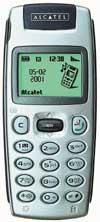
It was invented in the 1960s, but until 1979 the mobile phone system was not launched in Tokyo. However, until 1983, when Motorola came into force in the United States, the era of real wireless services was not initiated.
Internet

Internet is a computer network for computer communication. The Internet Protocol (IP) and the Transmission Control Protocol were developed in 1973. Initially, the network was called ARPAnet and connected several universities, institutions and research laboratories in the United States. The website began to develop in 1989.
Buletina
Bidali zure helbide elektronikoa eta jaso asteroko buletina zure sarrera-ontzian











